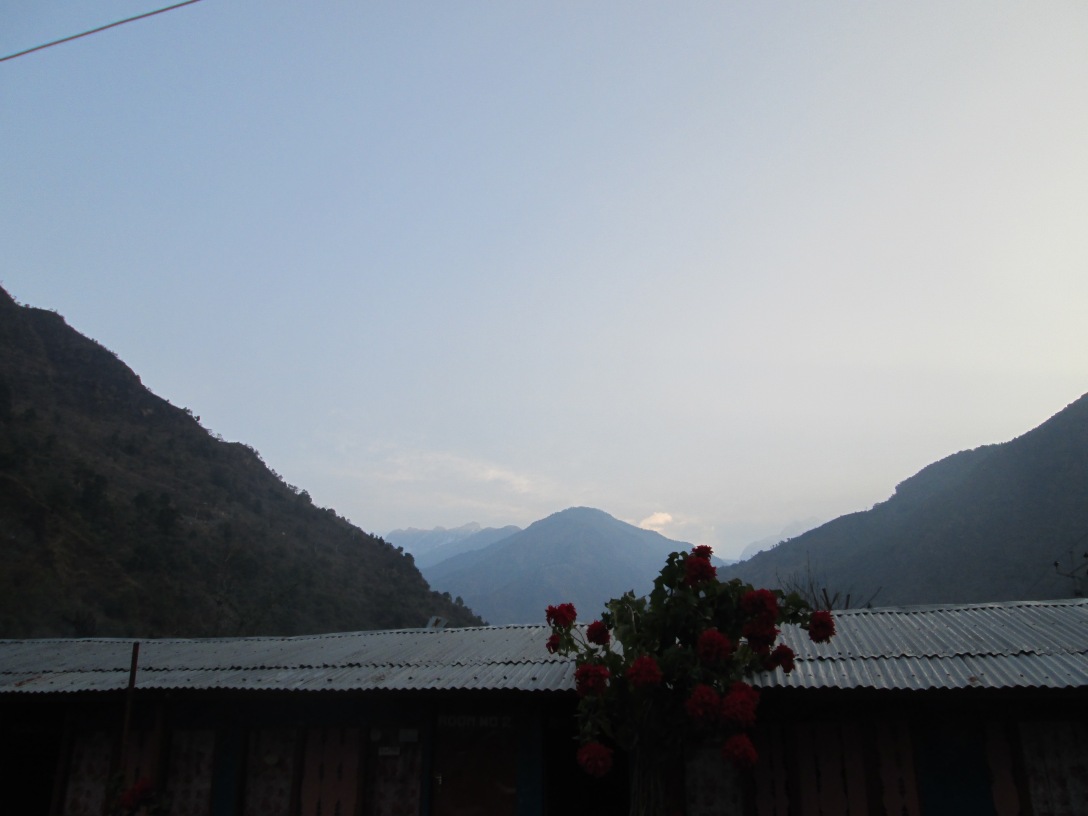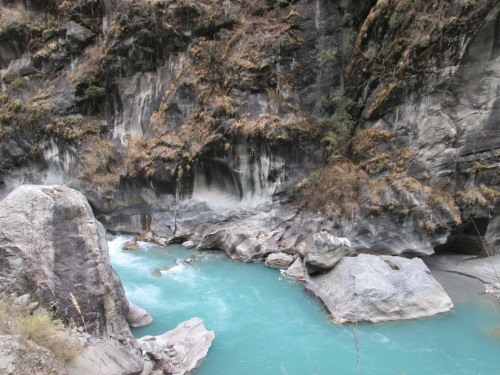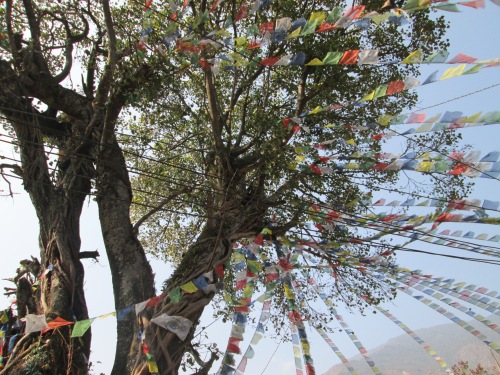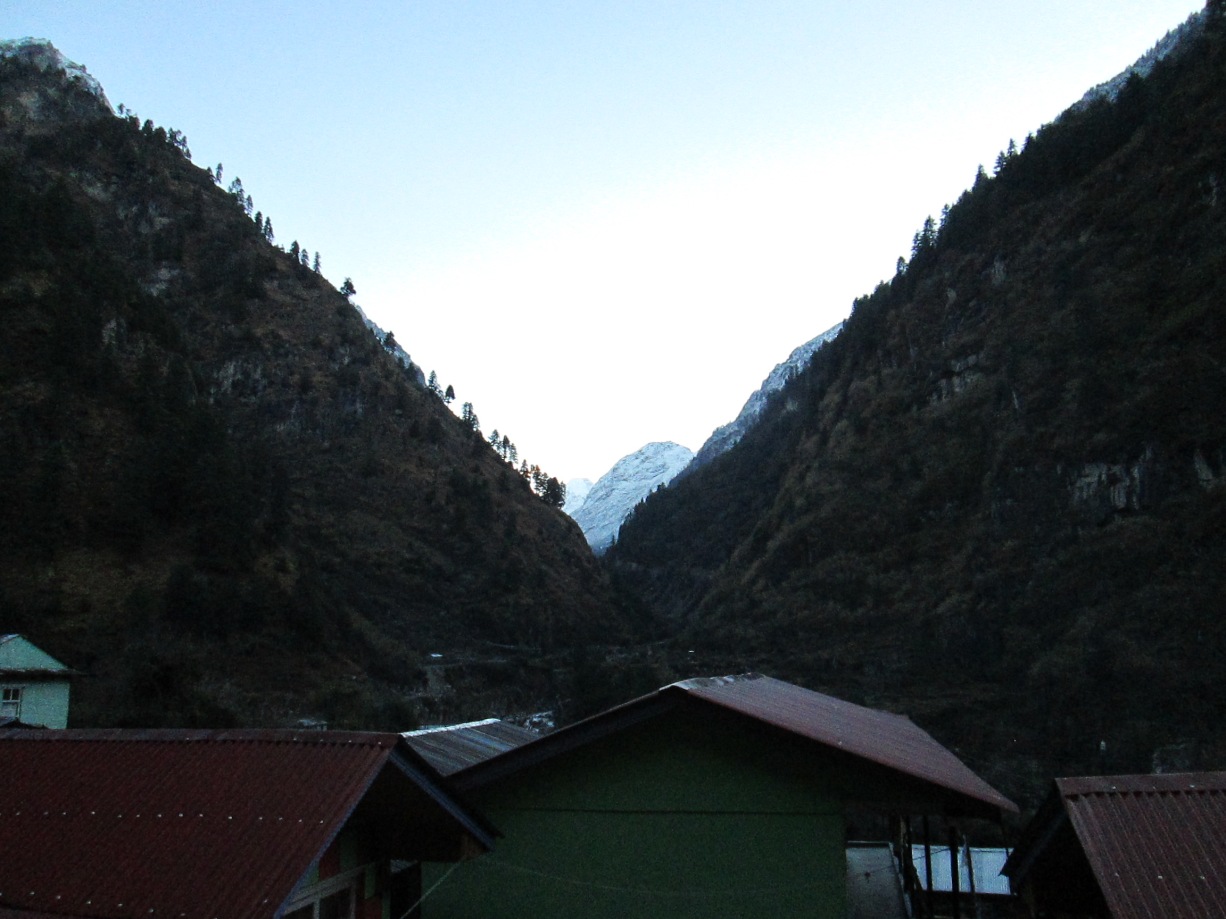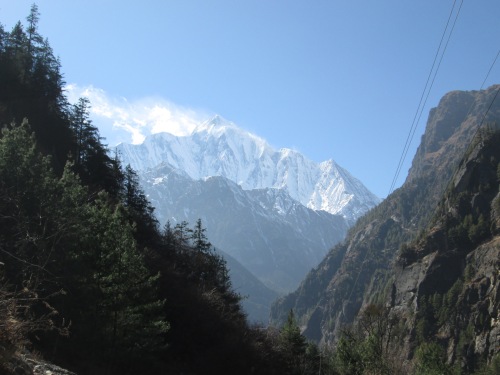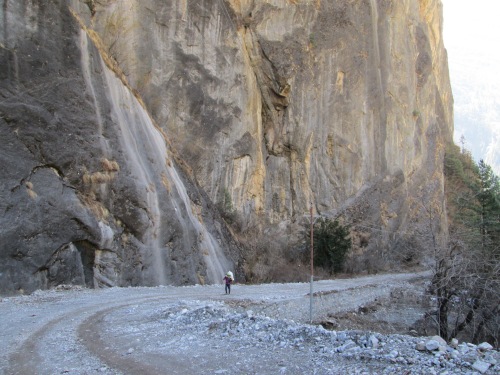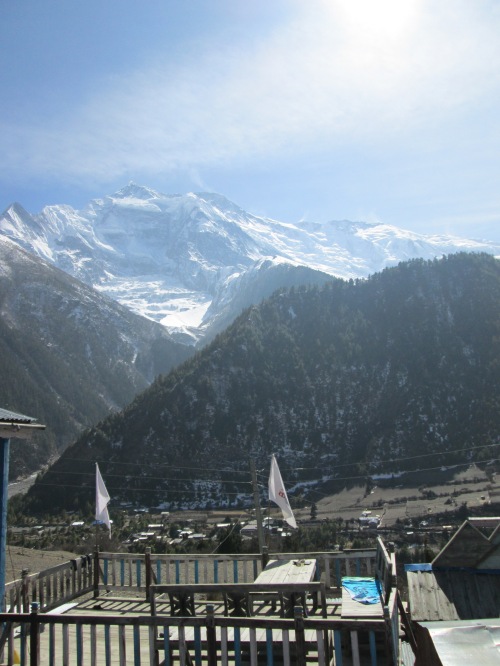When we reached the town of Manang, we rested a day, as was suggested to avoid altitude sickness. At 3,540 meters Manang was about where the effects of higher altitude could start to be felt. From here on out it was short days with moderate elevation gain, post arrival acclimatization hikes, and paranoia about possible sickness rumbling gently through the trekker community like the thunder of a far-off storm. Without much understanding of what provokes altitude sickness in some people and not others, each of us was poised for a bad roll of the dice and we tracked fleeting symptoms like a club of hypochondriacs.
Manang sat in a broad river valley and stretched lazily over the neighboring hill. The main drag was a wide dusty strip bordered by dingy trekkers shops. Rugged faced shop keepers would appear to sell Snickers and sunglasses, taking a break from card games played on stoops across the street. Hotels like Yak, Himalaya View and Tilicho Lake competed for business with gas vs. solar heated showers, and Western vs. Asian toilets. No one had wifi because the electricity was out. Crowds of goats trotted through town, spreading in all directions like hyperactive school children. Lines of shaggy horses dutifully plodded one way down the street in the morning, and back the other in the evening, exchanging the odd niblet of brittle grass for the mucky stable.  A little boy rode up and down the strip on a plastic tricycle, cheeks the color of cranberries, puffing out like balloons. His clothing was layered so many times that his arms could barely bend under the bulk; a mini Michelin Man parading through the set of The Good, The Bad and The Ugly. North of the main strip, stone houses clambered up the hillside, narrow and muddy streets winding through a cluttered arrangement of houses and stables and prayer wheels.
A little boy rode up and down the strip on a plastic tricycle, cheeks the color of cranberries, puffing out like balloons. His clothing was layered so many times that his arms could barely bend under the bulk; a mini Michelin Man parading through the set of The Good, The Bad and The Ugly. North of the main strip, stone houses clambered up the hillside, narrow and muddy streets winding through a cluttered arrangement of houses and stables and prayer wheels.
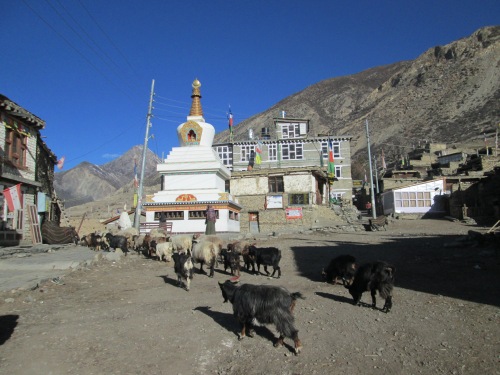
Goats in Manang
We stayed in the Himalaya Singha, a big south facing hotel with a broad dining area centered around a cast iron stove, which was lit at dusk with wood and yak dung. Idle trekkers sat at the long tables, biding their time with eating, Kindles, cards and chat. A little circle of porters laughed over dal bhat and constant cards games. It was the final cement that bonded us, a band embarking on the last stretch to the exalted high pass, Thorong La, a few days away. Here our little crew expanded to its full and final proportion. We were the original four from trekkingparters.com, and Harry of course, plus the German and South African, plus the two 18-year old Australians and a British man who’d been held back a day by a tooth infection. The only girl in a sea of males, dirty and disheveled in my ugly hiking pants and striped touque, I felt like a female incognito, privy to conversations ad nauseum on farts and bowl behavior. But bowel matters aside, as we shrugged on our bags to leave the city, we made a pretty great team.
We left Manang on one of those perfect blue sky sunny days, the kind where the world appears new, cleansed by some ethereal hand and laid out again dancing. Strings of candy floss cloud fluttered out of the mountain peaks, the ponies trotted out to their brittle grass patches, and the little boy on the tricycle giggled with glee. Looking back from the first bluff outside of town, the city shone like something magical—all dust and dirt and dung glossed over. One could almost see throngs of galloping horses, with crying men, spears drawn, charging at some mountain foe. Horns blown in unison, prayer flags turned battle symbols, and stupas monuments to the fallen.
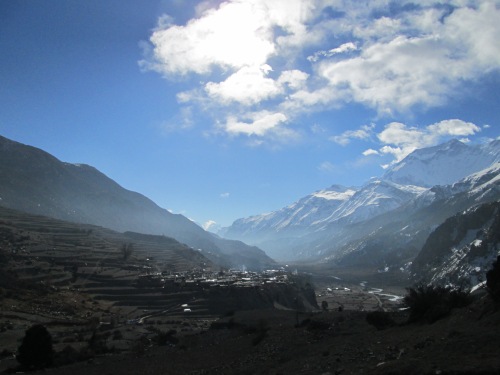
Leaving Manang
That day we walked to Yak Kharka, a tiny conglomeration of shabby guest houses and stone walls shoved in a narrow, shaded valley. By the time we flopped our bags down, I could no longer pretend I felt well. The phantom headache I’d pushed off that morning had blossomed and I was feeling increasingly nauseous and lethargic. Bundled in the lodge around a hopping fire fueled on spindly wood and yak dung, our crew had become a team of amateur pharmacists. Sean had Diamox, and Tylenol. Matt had ibuprofen and activated charcoal. Ben had paracetamol. A little man in the shop in Besisahar who had sold Matt Diamox, the altitude medicine, had said “no sick, no take.” But a man in Kathmandu who’d sold Sean his had told him to take between one and four a day. It was a pill popping party, over by 8pm. I watched in a gloom the energy of the others, playing cards and laughing. Jake was on his second dessert. Sean began telling us again about the burger he would eat when he got to Hawaii.
As we tried to fall asleep that night bundled in every layer we had, including our toques, Jake humored me by comparing pulses and exchanging paranoias, his being that a snow leopard would attack him on the way to the outhouse. The next morning I felt a little better, but that was only temporary.
That day we reached Thorong Phedi, the last stop before the pass. At 4,450 meters, Thorong Phedi stood at the end of a long, narrow valley, rammed in the clasp of mountain tops that sealed off the riverbed like a giant wall. It was a barren place with just two guest houses and a frigid wind that whistled lonesomely around the buildings. The first lodge was the bigger one and got the majority of business, it being situated 30 meters lower than the other. Behind the lodge was a vertical incline that stretched up for 400 meters. It was the start of what awaited us the next day and what we were supposed to hike up and down that afternoon to help with acclimatization. “Climb high, sleep low” was the adage. After the morning’s respite, my sickness had seeped back even worse. I was like a high slug, lolling about with air in my head. I hiked up the incline with the others, each step a horrendous weight, and tried to remind myself that this was voluntary.
I went to bed as soon as it was dark and awoke at 10pm with that knowledge that the night was going to be torturously long. I felt more nauseous than I could ever remember, like my body was a giant dam holding back a mountain of sludge. My head ached like a lawnmower. It was some sub-zero temperature, there was no internet and I could think of nothing but the pain, like my brain had been erased and filled with a bucket of gravel that clattered around incessantly. Later, I sat outside under a close starry sky, alternating between a duty-free bag, and the pitch-black squat toilet. Around me wind whistled, and the rustle of some cow or dog or human clinked in the shadow. Eventually I managed to lie down again and sleep in mini fits waiting for morning when I would tell the rest that I wasn’t going any farther. When the last of the group rounded the dark corner of the lodge early the next morning and disappeared, I went back into my room and sobbed. Perhaps a combination of sadness, exhaustion, fear and disappointment, alone on a dark, cold mountain, a bag of pink tinged vomit next to my bed.
A few hours later, a small appetite regained, I ate my cold breakfast bun which I’d ordered the night before and which hadn’t yet been cleared from the table. I spread on peanut butter from some jar someone had left. Three ballsy Australian guys prepped for a later climb, excited about the peanut butter and successful pre-ascent poops. I told them about my pink-tinged vomit and that was the last we saw of each other. We shouldered our bags and headed in opposite directions.
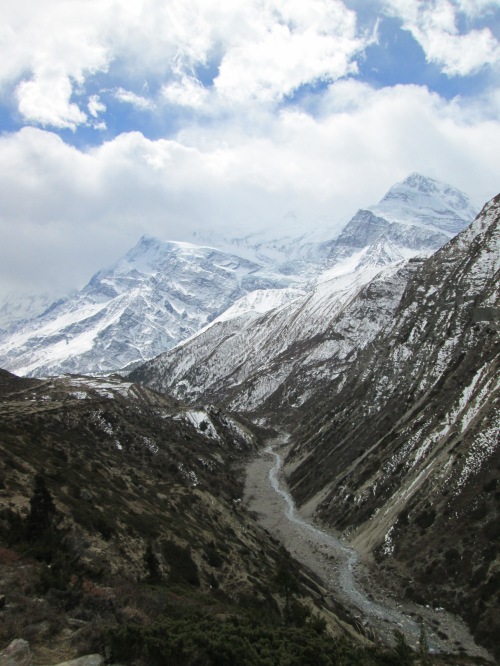
Not a bad view down the valley
As I walked back down what had taken us two days to come up, the clouds bantered with the sun, shadows whipping through the valley like pieces of some high up game. I imagined the guys slogging over the pass, imagined them coming down the other side and sipping their first beers in the long-anticipated celebration, and I felt tears stinging at the sides of my eyes. Everyone I passed wanted to know why I was going the opposite direction. I dreaded running into anyone I knew; and of course, I ran into them all. That night back in Manang, I couldn’t shake the feeling of having given up, and I considered trying again. It was either that or take a jeep down a deathly cliffy road for 10 hours, back to the starting point where I could meet up again with the group. If I returned to the pass it was another week of walking, alone, or with whomever I might meet along the way, and I could still get sick again. After a fitful sleep I awoke early with my mind made up: back up to the pass it was, and this time I was going to make it.
It was another bluebird day when I left Manang for the second time. I passed the same woman selling bracelets and trinkets, the same boy on the tricycle and ponies ambling up the path. Again, the city looked like the site of a medieval battle and candy floss trailed off the mountain tops. The woman selling trinkets asked about my friends, “did they make it over?” she wanted to know. I was surging with energy, healed and made stronger in just one night lower down. Half an hour out of Manang I met a small group of hikers. One of them was a German girl of 20 something, who extended her hand, beaming: “Hi! I’m Tessa,” she said. I recognized her from trekkingpartners.com—we had been planning to hike together but then our schedules didn’t quite align. And here we were like some funny little twist of fate.
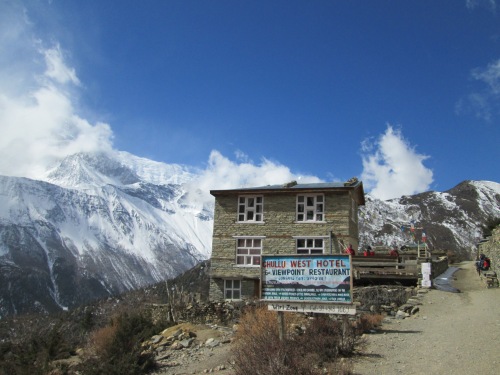
My favourite tea house
In two days we were back at Thorong Phedi. I was surprised that the manager of the guest house recognized me, “you can have your old room back,” he said with a wry smile. He was a tall, Nepali man with a wide face and toughened skin, and he was normally gruff and snappy with a sarcastic wit lurking behind his eyes. I wondered what it must be like for that man, serving so many people, seeing them all at the last stop before they crossed the highest point on the trek. A buildup of energy each day and then they were gone—over and away, and a new group came and it repeated. It must get a little lonely, being always something by the wayside. Along with Tessa, I met three Canadians, one of whom was from close to my home town. We chatted and ate and planned to hike over the pass together the next day. A group of Swiss were trying to fix the struggling fire which was overloaded with wood and yak dung. A girl in wool socks sat splay legged on the floor pulling out pieces of poop and wood and a man came over and dumped kerosene from a little metal bottle on the stubborn contents.
We left the next morning at 4:45. It was dark still but the approaching sun was already brushing the sky, softly pushing away the half-moon that lingered. We zigzagged slowly up the first steep slope among sleeping mountains, until finally they were clothed one by one in sunlight. At the top of the first climb was the very last tea house, and we stopped to warm up. But it was ineffective. The hut was freezing with thin wooden walls and a brave shopkeeper bundled up in layers that could not have staved off the aggressive cold. The water in our bottles had frozen around the edges, and chunks of it clinked in the middle.
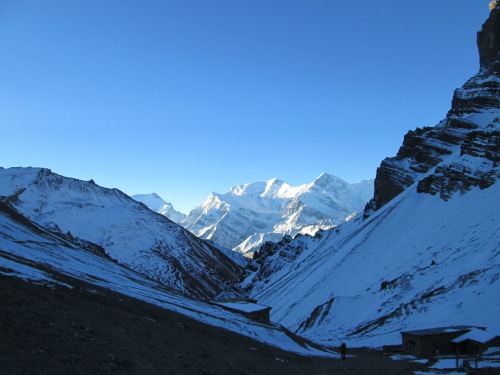
View from High Camp
Outside the tea house we rounded a corner and the world changed. Snow covered the ground and the wind whipped it into our faces, swirling like a living thing, pushing us along or pushing us back. Our feet slipped on the narrow ledge, and the wind wiped over our steps so we could barely make out the footprints of the one in front of us. Reality narrowed now to breathing and stepping, head down, step after step. Each one to himself, in a small interior world. It struck me how vulnerable we were out there—foreign creatures in an inhospitable land, our delicate skin wrapped under layers of protection, our lungs rebelling at the thin air, our legs weak. Every nagging worry was gone, we were our bodies, our blood, our breath, harshly alive.
Finally, we reached an area warmed by the sun and the wind died down and a while longer we were at our destination. A mass of prayer flags strung up like a lonely fair ground and amassed around a small wooden sign: “Thorong-La Pass—Congratulations!” It read. “5,416 meters.” I felt a giant surge of happy sadness. The sun shone blindingly and around us mountain peaks and glaciers creaked in it. There was not the epic view I had been imaging, it was a white place in a bowl of peaks.

Thorong-La Pass
We took a few photos and then we went down, down, down 1,700 meters in a seemingly never-ending slope of brilliant snow, boiling hot, sweating now, layer upon layer stripped off, sliding down the melting hills into the neighboring valley.
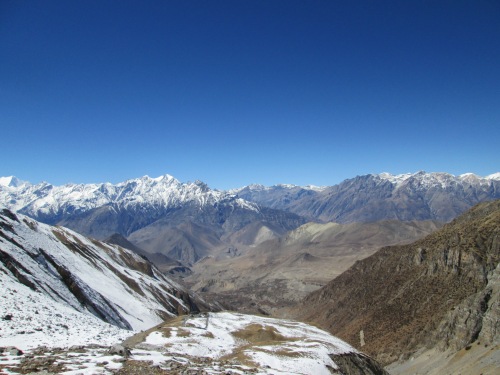
The valley on the other side
When we reached Muktinath that evening we showered and refilled our bodies on dal bhat and the sun streamed through the windows and soaked into our skin and we switched on our phones and the world seeped back in a little. And it was funny to see how we meant something again, while we’d meant nothing up there.
The next days, Tessa, Max—the Canadian from near my home town—and I walked down the valley together. A new little band of the necklace. It was a beautiful feeling going back down, life buzzing and creaking and vibrating around us, back to where we belonged. And there, everything seemed possible.
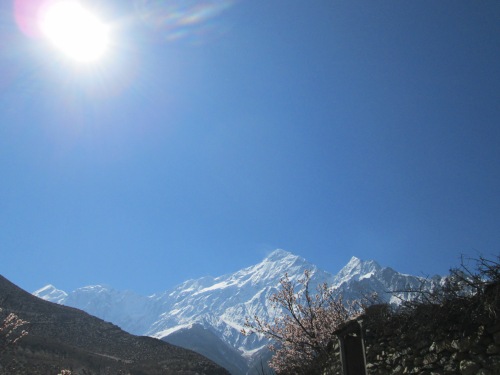

![20180222_114128[1].jpg](https://tararachael.wordpress.com/wp-content/uploads/2018/04/20180222_1141281.jpg?w=500)
